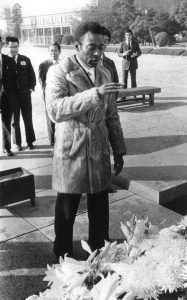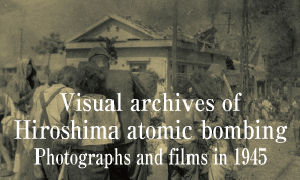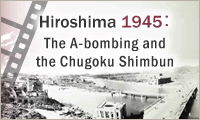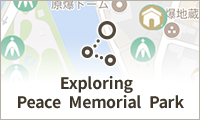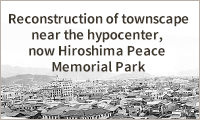Documenting Hiroshima 80 years after the A-bombing: November 1974, the “king of football”
Apr. 24, 2025
Pelé could not leave Japan without visiting the Cenotaph for A-bomb Victims
by Kyosuke Mizukawa, Senior Staff Writer
On November 26, 1974, Pelé, the king of football, visited Peace Memorial Park in Hiroshima. As a football ambassador for Brazil, he made a memorable impression. Pelé passed away in 2022 at the age of 82. Fans, cameras in hand, rushed to see him. He laid a flower wreath at the Cenotaph for A-bomb Victims and posed for photos with local children.
Pelé was a global star who won the FIFA World Cup three times after making his debut in the World Cup in 1958 at the age of 17. In May 1972, playing for Santos Futebol Clube of Brazil, he scored two goals against the Japanese national team at the National Stadium in Tokyo, thrilling Japanese football fans.
Pelé returned to Japan after a two-year absence to teach the younger generation about football in Tokyo and Hiroshima. According to the Chugoku Shimbun at the time, he expressed a desire to visit the cenotaph while on the plane to Hiroshima.
He was unable to visit the Peace Memorial Museum
After laying the flower wreath, Pelé said in an interview that he was well aware of the damage caused by the A-bombing of Hiroshima and that he could not leave Japan without visiting the Peace Memorial Museum. He expressed regret that he was unable to visit the museum due to limited time. After retiring in 1977, he became involved in social contribution activities such as the United Nations International Children’s Emergency Fund (UNICEF), making use of his global name recognition.
In fiscal 1971, the number of visitors to the museum reached 1,074,465, surpassing one million for the first time. Of those, 34,645 were international visitors, accounting for 3.2 percent of the total. Around this time, prominent figures from abroad began showing interest in supporting A-bomb survivors and in documentary films about the A-bombing.
In September 1971, the UK rock band Led Zeppelin donated about 7 million yen to Hiroshima as a fund to support A-bomb survivors— proceeds from a charity concert held in the Hiroshima Prefectural gymnasium. According to an article from the Chugoku Shimbun at the time, the Hiroshima concert was realized by the group’s special wish, and approximately five thousand people were in attendance.
The members of Led Zeppelin, including 27-year-old guitarist Jimmy Page, presented a list of the donations to Hiroshima Mayor Setsuo Yamada at City Hall. At that time, the Chugoku Shimbun published an article quoting Mr. Page as saying that even those who had not experienced war felt a sense of shame that human beings had dropped the A-bombs.
Mr. Lennon and Ms. Ono were also intensifying their anti-war message
John Lennon (who died in 1980 at the age of 40) of the UK rock band The Beatles, and his wife, avant-garde artist Yoko Ono, took an interest in the film, “Effects of the Atomic Bomb on Hiroshima and Nagasaki,” which was returned to Japan from the United States in 1967. The Diplomatic Archives of the Ministry of Foreign Affairs of Japan holds a document bearing their joint signatures in December 1969, requesting Prime Minister Eisaku Sato distribute the film.
The document emphasizes it is the responsibility of the Japanese people to convey the atrocities committed in Hiroshima and Nagasaki to the world, in order to prevent their repetition. In the Japanese version released by the Ministry of Education, vivid descriptions of human suffering were omitted, and Mr. Lennon and Ms. Ono advocated for the distribution of the unedited version.
In 1974, amidst the Vietnam War, Mr. Lennon and Ms. Ono were intensifying their anti-war message by putting up billboards that read, “WAR IS OVER! IF YOU WANT IT” in major cities around the world. The Japanese government declined to distribute the film.
(Originally published on April 24, 2025)

